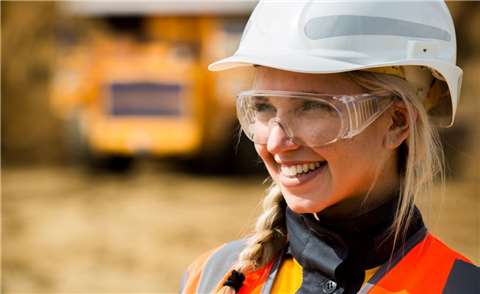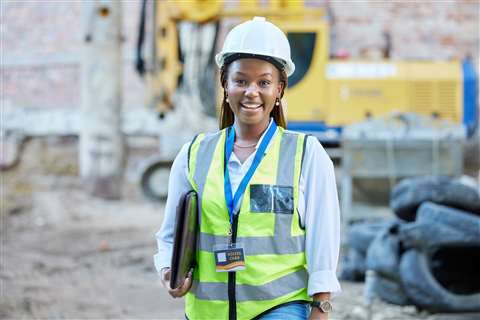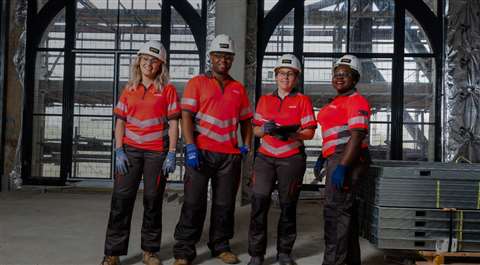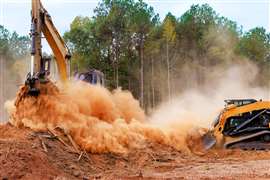Are women winning the battle for representation in construction?
07 March 2023
All sorts of things can differ across international construction markets, from architectural styles, to favoured construction methods and equipment.
 Keltbray’s Gender Pay Gap report says almost one five of its workforce are female, with an increasing number of women in senior positions. (Photo: Keltbray)
Keltbray’s Gender Pay Gap report says almost one five of its workforce are female, with an increasing number of women in senior positions. (Photo: Keltbray)
But there is one area where almost all of them share something in common: The under-representation of women.
As the world marks International Women’s Day 2023 (8 March), International Construction has examined representation of women in construction markets around the world, as well as the efforts underway to redress the balance.
While figures and the methodologies used to collate them vary, women still typically only make up 10-15% of the construction workforce across the world. And that falls to single figures for site-based roles.
Although there has been progress in some markets, the fact that 8.5-9 in every 10 construction workers is generally male shows that there is still a long way to go.
And yet there are signs that women are gradually finding more career opportunities in the industry, often driven by what has traditionally been a male-dominated sector being forced to change by skills shortages.
Common challenges
Throughout the globe, from the US, UK and Europe, to India, Japan, and South Korea similar challenges arise. They include:
- Workplace prejudice, discrimination and harassment
- Lack of flexibility, particularly for site-based roles, and a culture of presenteeism
- Gender pay gaps that see male workers earn more for the same roles than their female counterparts
- Lack of representation of women in senior management roles, which means a lack of role models and mentors for more junior female construction professionals
- Lack of adequate welfare facilities for women on site
Drivers for change
Nonetheless, there are drivers that are encouraging construction companies to make their staff more gender diverse.
Susannah Donaldson, legal director, employment law and global co-lead, equality, for law firm Pinsent Masons works with many of the UK’s biggest construction players to provide advice on equality law and internal strategies to increase gender diversity.
She notes that diversity and inclusion is now one of the top strategic priorities for major contractors. Two chief reasons for that, in her view are:
1) An acute shortage of skills, which is forcing companies to realise that they need to cast their net more widely.
2) The industrialisation of construction, which sees construction companies competing against tech giants for the top talents.
A shortage of skills isn’t just driving efforts to boost gender diversity in the UK. In Japan, a recent report by Kensetsu Komachi, a campaign set up by the Japan Federation of Construction Contractors to encourage more women into one of the most male-dominated construction markets in the world, notes: “Today, as Japan’s total population turns to a declining population and we are about to enter a declining society, we believe that it is essential to bring out the potential of women in order to maintain a vibrant economy and society. There is an urgent need to create a corporate culture in which women can play an active role in all areas of business.”
 Image: Siyavuya Pato/peopleimages.com via Adobe Stock
Image: Siyavuya Pato/peopleimages.com via Adobe Stock
In Australia, high demand for construction workers is waking construction firms up to the benefits of gender diversity. “Just 12% of the construction workforce are women, meaning the industry is missing out on employing half the working population—and this is at a time when a massive 105,000 additional construction workers are needed to deliver Australia’s project pipeline,” says Jon Davies, chief executive officer of the Australian Constructors Association.
“The underutilised pool of talent that women represent is enormous. But in a classic case of chicken and egg, the ability to attract women is linked to the industry’s poor culture and its poor culture is, in large part, linked to the lack of women,” he adds.
Efforts to redress the balance
Some construction companies have started to attempt to redress the balance. Often, that comes in the form of commitments to improve future diversity levels. UK-based contractor Laing O’Rourke has set itself the target of ensuring that the number of men and women employed in its international staff (currently 5,500 people) is equal by 2033, for example.
 In October 2022, Laing O’Rourke introduced a range of workwear, inspired by Formula 1 pit crews. It designed a range of items specifically designed for women with a view to attracting more women to the profession (Image courtesy of Laing O’Rourke)
In October 2022, Laing O’Rourke introduced a range of workwear, inspired by Formula 1 pit crews. It designed a range of items specifically designed for women with a view to attracting more women to the profession (Image courtesy of Laing O’Rourke)
It piloted a Gender Diversity Action Plan in its Australian division. Initiatives involved creating a group commitment to hold leaders accountable for driving change and intervening to remove bias from behaviours and decision making processes. Separately, it is targeting 25% of senior roles on projects to be filled by women by 2025.
In common with many other construction companies since the pandemic, Laing O’Rourke has also introduced more flexible working practices and extended its outreach programme encourage the learning of STEM (science, technology, engineering and maths) subjects in schools, and promoting engineering as a career option to girls.
Donaldson says, “There is still a perception that construction is a very macho, boorish culture, particularly on sites. And that is definitely a challenge. So what I see is a real focus on trying to get people on board with why it is important to change their attitudes.”
Recently, contractors have shifted their approach to getting male workers to embrace change. Instead of talking about diversity and inclusion, some construction employers are encouraging them to look at gender diversity through a helath and safety lens, says Donaldson. “Health and safety is something that is drummed into everyone in construction and it is something that workers get,” she explains.
“So rather than talking about diversity, the way some of the companies I work with are positioning it is to talk about psychological safety. Basically, it is about making people feel empowered to speak up about incidents or concerns that they may have.
“We have worked with two of my clients, Kier and Balfour Beatty, on campaigns around addressing these deep-rooted cultural issues. Kier had one called Expect Respect, and Balfour Beatty just launched one called Right to Respect. It is about trying to get everyone on board and aligned with their values and making it clear.”
Gender pay gap
The disparity in pay between men and women is common across international construction markets and serves as a significant barrier to more women embarking on careers in the sector. It’s particularly acute in markets like India.
A report by Primus Partners and World Trade Center entitled ‘Pink Collar Skilling’ and published at the start of this year, highlighted the problem in India. It said, “Women are mainly employed in the lowest paying and most hazardous tasks (like lifting heavy loads), including brick kiln workers, quarry workers, slab pouring, stone shaping, load carriers, and assistants. These jobs are labour intensive, cause health hazards and are not well paying.”
Only 1-2% of women reach top-level management positions in the industry, the report added, making it difficult to effect change.
Khair Ull Nissa Sheikh, board member of the World Trade Centers Association, which helped to produce the report, added: “The issue of wage inequality is still deeply prevalent, and highlights the need for skilling and other reforms to make the workforce more diverse and inclusive.”
Speaking to Construcción Latinoamericana, Claudia Petit, president of Mujeres en Construcción (MUCC), a Chilean non-profit organisation that promotes the role of women in construction, highlighted the importance of getting closer to universities and professional institutions.
She emphasises that it is important to make it clear to students entering the industry that it should not be normal for women to be paid less than men or for men to enjoy better career development. She said, “I think that if we focus on education, we will have professionals in the future that are much more empathetic with the difficulties that women can have in the arena.”
The fact that companies generally aren’t obliged to reveal what they pay workers has held down progress in this area. But in certain regions, this is starting to change. At the end of 2022, the European Parliament and Council reached a political agreement to introduce a directive that creates new rules for more transparency and enforcement on equal pay between women and men.
It will require companies to report on their gender pay gap, and where there is a gap of more than 5%, they will be required to carry out an audit on payment practices.
Some countries - including the UK and Italy - already have government rules on gender pay gap reporting in place. But Donaldson hopes the new EU directive will spark further progress. She says, “It is going to have a transformational impact on remuneration practices and I think provide a real incentive for organisations to get more women up to senior levels within these organisations. Because if all your women are concentrated on the lower levels and all your men are concentrated in the senior high-paid levels, that is what creates the gap.”
She also cites changes to government procurement policies, such as a move in the UK to score public tenders not purely on lowest price but on aspects like social value, as potential drivers of change. “[Public sector clients] do look at things like gender pay gap statistics and what contractors are going to do to improve social mobility and the number of apprenticeships etc. This provides another business imperative the focus on all of this. Companies are not just doing it because it is the right thing to do – it is in their own financial interest to do so,” she adds.
Winds of change?
There are signs that more women are graudally starting to enter the construction industry in greater numbers. In the US, the share of women in construction hit a record high at the end of last year, according to official figures.
In Japan, where the proportion of female construction workers was reported to have been as low as 3% in 2018, change also appears to be on the way, admittedly from a low base. In a recently published action plan, members of the Japan Federation of Construction Contractors targeted an increase in the percentage of female engineers of 10% in 2024, from 3.3% in 2013. It also wants to see 2,100 women in management positions of member companies by next year, up from just 623 a decade ago. And member companies expect to have female toilets and changing rooms on 100% of their sites by 2024, up from 45% and 31% respectively in 2018. The Federation claims that women now make up 15% of Japan’s construction workforce, although this applies only to major companies.
Petit said that the issue of abusive language on construction sites needed to be addressed, although she had heard of recent examples of men being removed from construction sites for unacceptable language.
And she stressed the importance of bringing women into senior management positions. She added, “Women must reach board level, something that is being studied in a proposal with a quota law, because when women reach decision-making positions, they can make a change towards the rest of the organisation.”
There are also associations across the world in different countries representing women in construction. Some offer bursaries for training and mentorship programmes. See the list below for more details of associations in your area.
Jon Davies, of the Australian Constructors Association, concludes: “Aside from the fact we are missing out on employing almost half the working population, we believe the that greater gender diversity will have a profound and positive impact on the culture of our industry.”
Organisations promoting women in construction
International Construction has compiled a list of some of the organisations promoting greater representation of women in construction across the globe by region.
They include:
Australia:
Canada:
Canadian Association of Women in Construction (CAWIC)
Chile:
France:
Germany:
Japan:
New Zealand:
The National Association of Women in Construction New Zealand (NAWIC NZ)
Singapore:
Association of Women in Construction
South Africa:
South African Women in Construction and Built Environment (SAWIC&BE)





